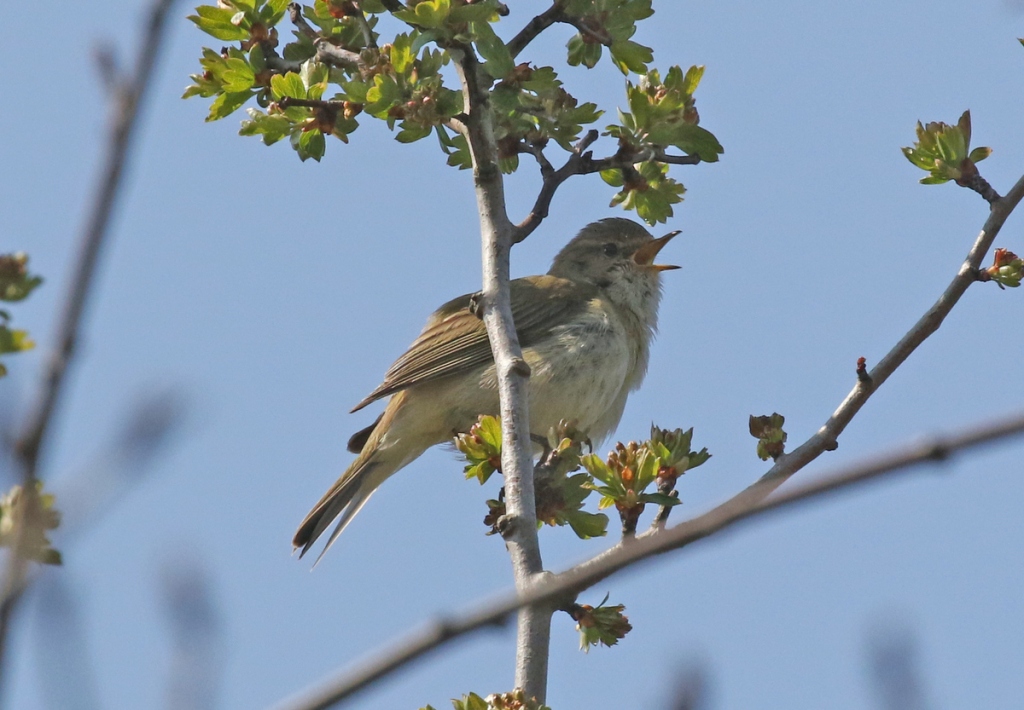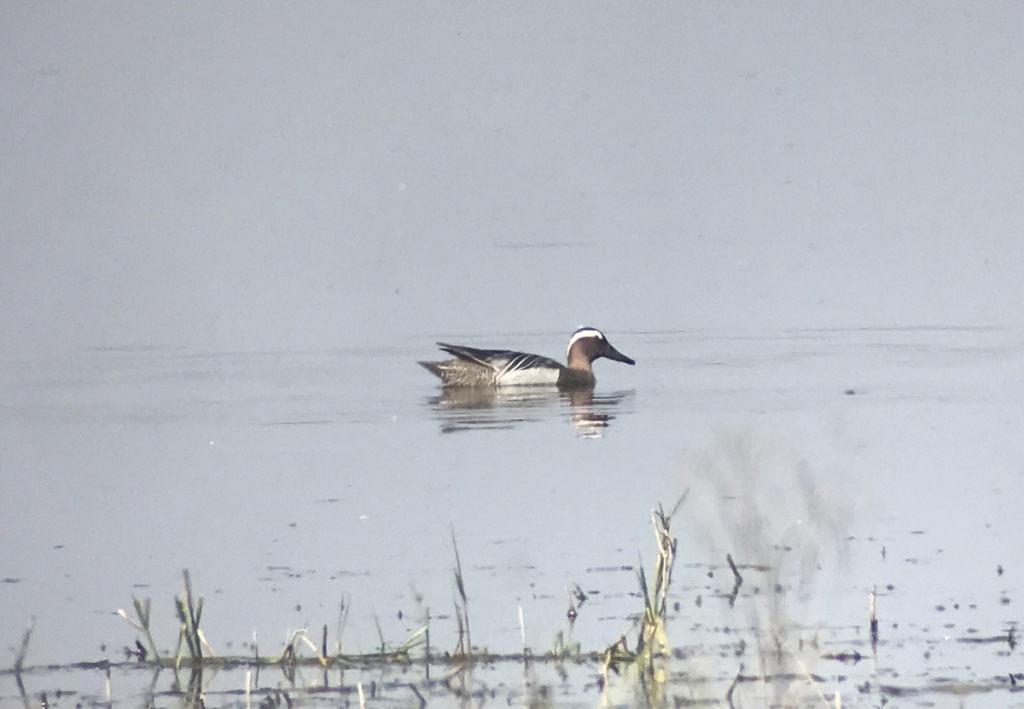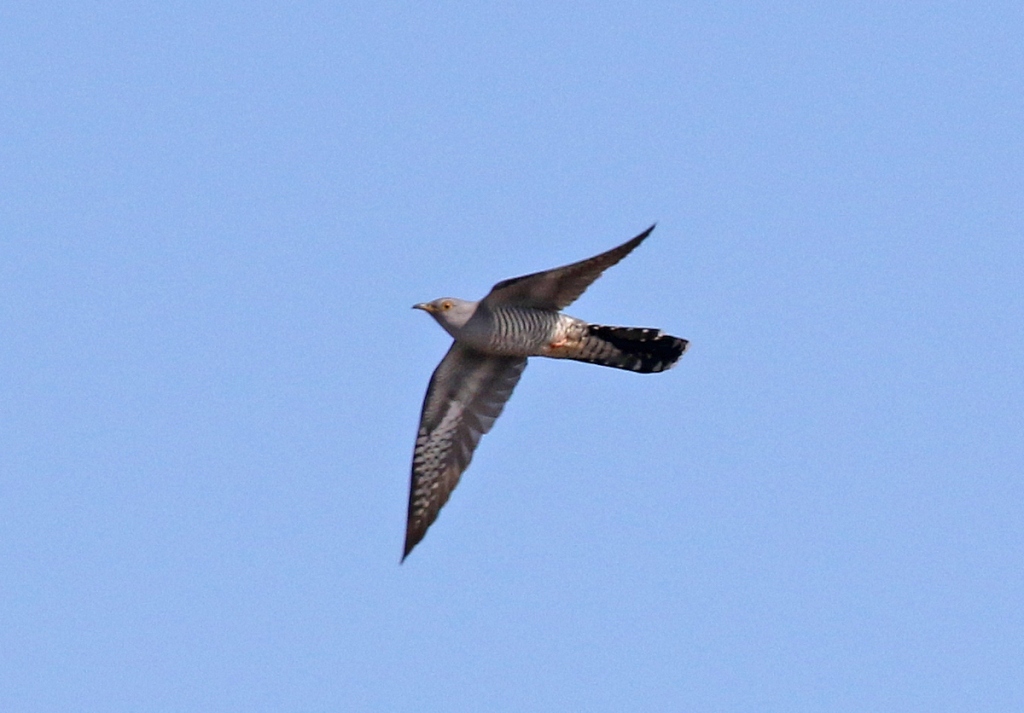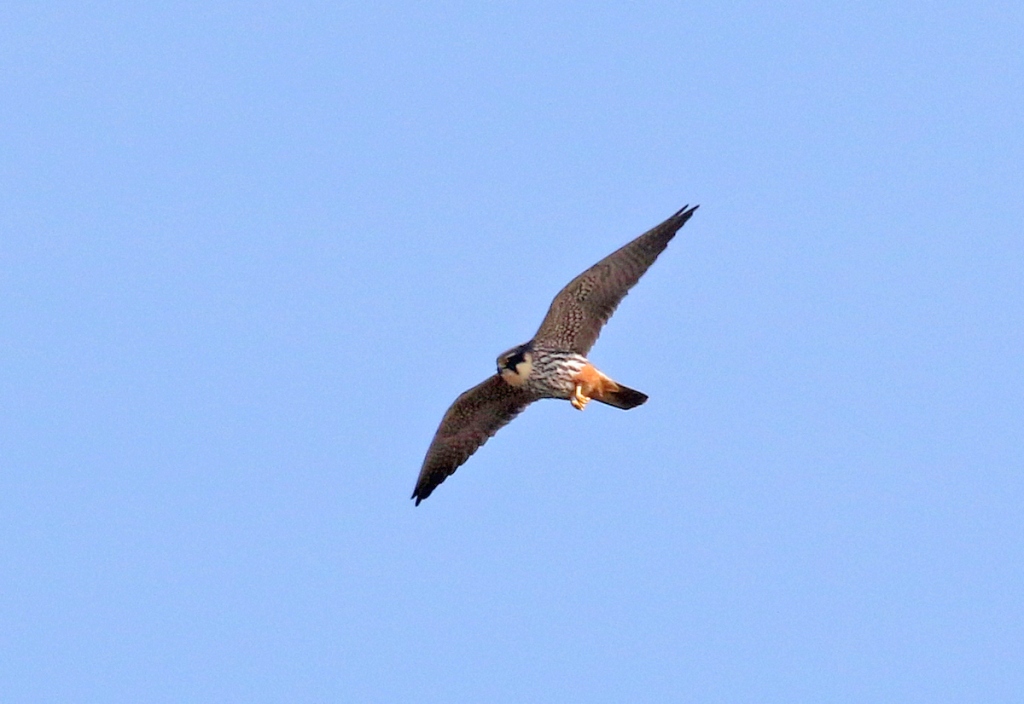A Private Tour today, down in Suffolk for Nightingales. It was bright and dry but mostly cloudy with some intermittent sunny intervals and a light but chilly easterly breeze.
Our first destination this morning was for Nightingales. As we walked down the road, we stopped to scan the fields and could see the orange face of a male Grey Partridge in the paddocks, the female feeding head down beside it. There were Skylarks singing and we watched one flutter up. We could hear a distant Yellowhammer singing its ‘little bit of bread and no cheese’.
Further down, it was bushier and we started to hear warblers singing. The sweet descending scale of a Willow Warbler contrasting with the repetitive chiffs and chaffs of a Chiffchaff. The beautiful fluting of a male Blackcap, flitting around in the fresh green of a spring hawthorn. The scratchy song of a Common Whitethroat in the more open bushes. There were Wrens, Dunnocks and Robins all singing too.

We heard the first Nightingale calling first, a strange croaking noise a bit like a frog, coming from a particularly dense tangle of brambles and bushes. As we stood and listened, it began to sing, a succession of loud, fluted, melodic, liquid phrases, pausing for breath in between. Gorgeous! It went quiet for a while, and we carried on down the road, where even more warblers were singing. Then we heard the Nightingale singing again behind us, so walked back for another listen.
The Nightingale was in a particularly dense area of scrub so there was little chance we would see it hear. We decided to tear ourselves away and have a walk round to see if we could find any more. A male Blackcap was singing by the road – a beautiful melodic song and a favourite on any other day, but unfortunately it was keeping elite company today. We found a path in through the bushes further up and weaved our way round. A smart male Yellowhammer perched in the top of a hawthorn above us, calling.

As we came to a more open area, flanked by thick bushes which were providing some shelter from the breeze, we could see some movement under a pine tree. As we walked up the slope past it, another Nightingale sang briefly just beyond. We stopped and listened and heard it again, calling now back behind us. We walked back into the open area and stood in the middle looking back at the sheltered edge, which was warm in the sunshine. it looked like there might be two Nightingales here, but they weren’t going to come out – the most we saw was when one flicked down along the edge briefly, but they were keeping to the thickest bushes and the trail quickly went cold. We could still hear the first Nightingale we had heard earlier, singing on and off behind us.
Continuing round, we noticed several Starlings zooming around the tops of the bushes. They seemed to be flycatching. There were more down on ground, running around snapping at things in the short grass and we could see one close to us had a bill full of insects. We couldn’t see what exactly they were catching, but it was obviously proving very productive here.

At the top of the hill, we could hear another couple of Nightingales singing. One was in a dense fenced-off area of bushes, but the second was in more open brambles and scrub. The sound seemed to be coming from the front edge, and as we walked along to investigate, we just had a glimpse of its bright orange-red tail as it flicked up from the grass and into the brambles. We could hear it calling further back, so we tried walking in on a path through the bushes. Again, we just saw the back end of it as it disappeared into the bushes.
We left it for a while, as we listened to the other Nightingale singing, then walked in slowly again. It was on the ground once more, but it was too close, behind a bush, and there was no way we could get round without disturbing it. We waited until it had moved further back, but still it was too jumpy and flew round the back as we tried to edge forwards. It wasn’t going to play ball today. We walked over to where the other Nightingale was singing from the thicket and listened to that for a bit. It was mesmerising just to stand and hear them sing.
It was midday now and things were starting to go quiet, so we decided to move on. A Kestrel was hovering out over the open grass in the middle, as we made our way back to the vehicles.
Our destination for the afternoon was Lakenheath Fen. We stopped for lunch first, in the sunshine, then afterwards headed in to explore the reserve. Several smart male Reed Buntings were in the bushes by the feeders. As we headed up to the Washland viewpoint, a Cetti’s Warbler shouted at us from the reeds.
There were lots of ducks out on Hockwold Washes again, Mallard, Gadwall, Shoveler, and a few Teal. Scanning round carefully we managed to locate one of the Garganey, right over at the back. It was busy feeding but when it raised its head we got a good view of the striking white stripe over its eye, a stunning spring drake.

There was a nice selection of waders on here too, including several Avocets. Six Black-tailed Godwits were feeding in the shallow water along the western edge but right in the far corner we could see three different godwits, slightly smaller and shorted-legged, with slightly upturned bills. Bar-tailed Godwits, normally a mainly coastal species and scarce inland, these are migrants on their way back up to the arctic for the breeding season and just stopping off here to feed. Two were smart spring males, with rusty head and underparts, continuing right down under the tail.
There were a few Common Redshank along that edge and then we noticed a paler wader there as well. It was hard to make out in the heat haze, so we walked a bit further up for a slightly closer look. It was next to one of the Redshanks now and we could see it was a Greenshank, slightly bigger, slimmer, and longer billed, another migrant stopping off here on its way north.
A female Stonechat was flitting around the reeds just this side of the river, landing on a fence, so we had a look at that through the scope. Then we continued on downstream along the river bank. A couple of Sedge Warblers and a Reed Warbler were singing from the reedy ditch on the edge of the reserve, but were tricky to see. The metronomic Reed Warbler song was noticeably different from the mad jumble of phrases from the Sedge Warbler, heard alongside each other. A Willow Warbler was singing from the sallows on the edge of the poplars too.
Looking across to New Fen North, we could see lots of Greylags loafing around on the drier areas in the reeds, with several broods of goslings. A female Mallard with several ducklings was swimming around on one of the pools by the river. A hungry-looking Grey Heron was standing on the other side of the water.
On the far side of West Wood, we cut back in to the reserve. A Cuckoo was singing in the trees, always great to hear this rapidly declining species back in the spring. Round at Joist Fen Viewpoint, we stopped for a break. A Cormorant was on the usual post and several Marsh Harriers were circling beyond. We picked up a distant Hobby, hawking for insects high over the reeds, then another two further back. Thankfully, as we sat and watched, they started to drift closer.
Scanning the pools just beyond the viewpoint, we found a Common Snipe lurking down in the cut reeds on one of the islands. We were just trying to get a look at that, when we noticed a Kingfisher further down towards Mere Hide. It was hovering over one of the pools, but quickly landed out of view before we could all get a look at it. Thankfully, a short while later it flew and came towards us, landing again in the reeds where we could get it in the scope and see its electric blue back.

Suddenly it was all action. A Cuckoo flew in over the reeds in front of us, past where we were standing and landed in the willow behind us, just beyond the Viewpoint. We had a great view of it the scope, we could see its golden yellow eyering. It stayed there for some time, singing on and off, and fluttering around in the branches looking for food.
Then a Bittern boomed from the reeds too. Always a great sound to hear. All the time the three Hobbys were now hawking over the reeds just behind us – a much better view now, we could even see their rusty red ‘trousers’ as they twisted and turned in the sunshine. From time to time they would catch something in their talons, then lifting it up to their bills to eat on the wing. For a while, we didn’t know which way to look!

After recovering from the long walk out, we set off to head back through the reserve. There were more Reed Warblers serenading us on the way – they seem to finally have arrived back in better numbers now. As we walked down the track past New Fen North, we could hear another Bittern booming from the reeds. We stopped to break the journey back at New Fen Viewpoint and we heard it booming again, but it was deep in the reeds and there was no way we would see it today. Still, at this time of year it is all about the amazing sound of Bitterns booming.
Back on the track, a Common Whitethroat was flitting around in the poplars singing. Back at the Visitor Centre, the Reed Buntings had been joined by several Goldfinches on the feeders.
Unfortunately it was now time to call it a day. But what a day, filled with the sounds of spring, wonderful to hear singing Nightingale, lots of warblers, booming Bittern and cuckoo-ing Cuckoo too.
















